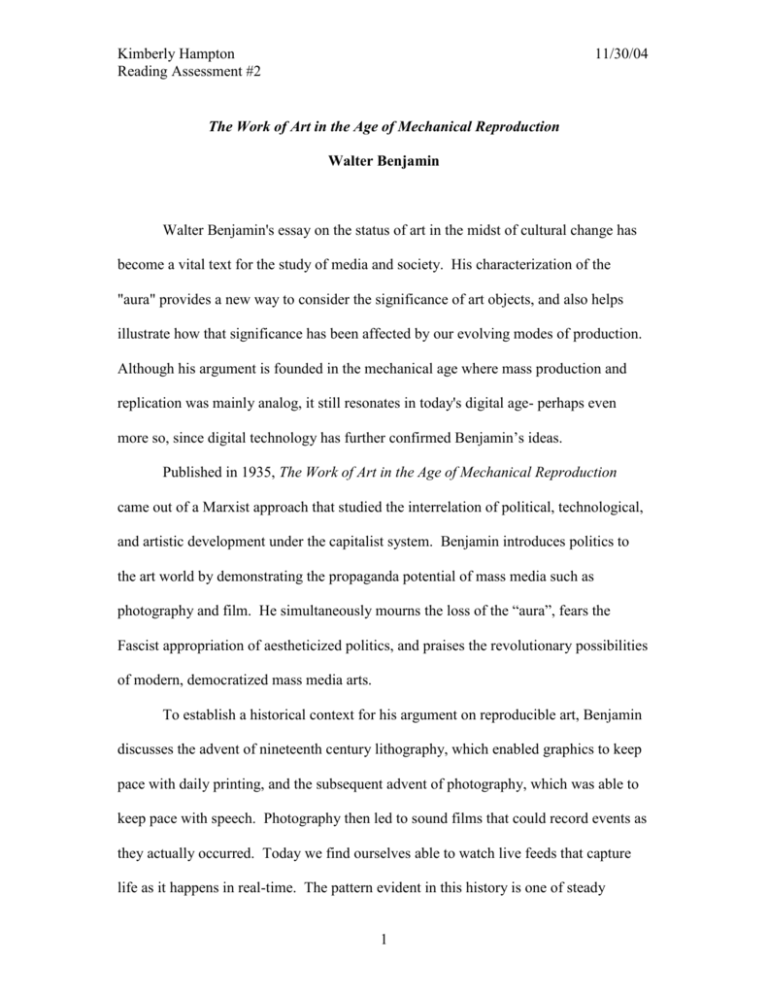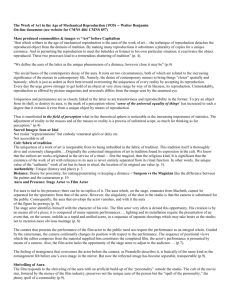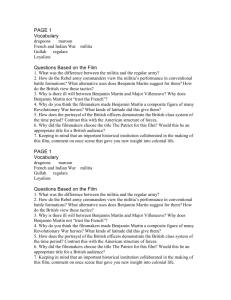The Work of Art in the Age of Mechanical Reproduction
advertisement

Kimberly Hampton Reading Assessment #2 11/30/04 The Work of Art in the Age of Mechanical Reproduction Walter Benjamin Walter Benjamin's essay on the status of art in the midst of cultural change has become a vital text for the study of media and society. His characterization of the "aura" provides a new way to consider the significance of art objects, and also helps illustrate how that significance has been affected by our evolving modes of production. Although his argument is founded in the mechanical age where mass production and replication was mainly analog, it still resonates in today's digital age- perhaps even more so, since digital technology has further confirmed Benjamin’s ideas. Published in 1935, The Work of Art in the Age of Mechanical Reproduction came out of a Marxist approach that studied the interrelation of political, technological, and artistic development under the capitalist system. Benjamin introduces politics to the art world by demonstrating the propaganda potential of mass media such as photography and film. He simultaneously mourns the loss of the “aura”, fears the Fascist appropriation of aestheticized politics, and praises the revolutionary possibilities of modern, democratized mass media arts. To establish a historical context for his argument on reproducible art, Benjamin discusses the advent of nineteenth century lithography, which enabled graphics to keep pace with daily printing, and the subsequent advent of photography, which was able to keep pace with speech. Photography then led to sound films that could record events as they actually occurred. Today we find ourselves able to watch live feeds that capture life as it happens in real-time. The pattern evident in this history is one of steady 1 Kimberly Hampton Reading Assessment #2 11/30/04 acceleration. Benjamin considers the last two technologies, photography and film, the epitome of how art has transformed its purpose and essence under the new modes of mechanical reproduction. According to the essay, the greatest transformation has been the loss of the aura. Benjamin defines the aura as, “the unique phenomenon of distance” (222). He uses the example of standing before a mountain and sensing the physical distance between the natural entity and oneself, or the distance apparent between a stage actor and his audience. The aura is the presence in time and space of an original work of art, which retains the authenticity and tradition that makes it unique. While art has always been essentially reproducible, only recently has the fundamental quality of that reproduction changed. Mechanical reproduction deprives art objects of their authenticity by removing the human element. For instance, photography is able to capture images that even the human eye is incapable of perceiving. Benjamin writes that, “the camera introduces us to unconscious optics as does psychoanalysis to unconscious impulses” (237). Also, a mechanically-produced duplicate can be recontextualized, further undermining the genuine substance and authority of the original piece. The loss of aura replaces permanence with transience and unique originals with replicas. Benjamin attributes this change to the contemporary crisis we have undergone at the hands of technological development. Our obsession with mass manufacturing and assembly-line construction has robbed people of their individuality, reducing them to cogs in a machine. Likewise, artwork has also been robbed of its unique presence. We accept this artificial reality as though we might overcome the loss of aura by embracing its reproduction. We are driven by a contemporary urge to bring 2 Kimberly Hampton Reading Assessment #2 11/30/04 objects closer to us, destroying the phenomenon of distance that defines the aura. Even now, the modern film industry is consumed by the challenge of capturing human forms in digital pixels. The film, Polar Express, is one example of our determined desire to replace authentic human actors with their digitized, lifeless clones. Technological possibility tends to overlook our actual experiences as human beings, and aims to bring us so close to the objects we strive to contain that their very essence disappears. Benjamin’s “aura” is anchored in a domain of tradition. He explains this premise by discussing how the earliest works of art originated from a ritualistic purpose. Whether referring to the religious cult that dominated medieval times, or the secular cult of beauty that dominated the Renaissance, Benjamin makes the point that art traditionally existed as a theology. When that theology is removed, we are left with a “pure” art form void of ritualistic or social function. That void is filled by political intention. Art and media begin to merge. Passive “art for art’s sake” is supplanted by a more active artistic expression of political struggle. Before, the consideration of art existed as a dichotomy; it could be seen as either a cult object where the value derived from its sole existence (such as certain ancient statues viewed only by high priests), or it could be seen as an exhibition piece where the value derived from its public presentability (such as the mass media that has developed today). In our current age, the exhibition value has superseded the cult value, creating an entirely new function outside of artistic intentions. The public quality of mass media, specifically film and photography, is what has redefined and politicized the function of art according to Benjamin’s argument. Some of the original cult value still exists in these new art forms, but a radical change has 3 Kimberly Hampton Reading Assessment #2 11/30/04 occurred. Traces of traditional cult value exist in early photography as “the cult of remembrance”, where artists choose to focus on capturing human expression through portraits of dead or lost loved ones. But as we move toward modern forms of expression, the emphasis falls on photography’s exposition, functioning more as political and historical evidence accompanied by directive captions and prescribed meaning. With the rise of photography came a debate over its validity as an art form compared to the classic traditions of painting and sculpture. This debate inevitably extended to the questioning of film’s legitimacy as well. Critics, such as Duhamel, condemned film as, “a pastime for helots, a diversion for the uneducated, wretched, worn-out creatures who are consumed by their worries” (239). They viewed it as a distraction for the masses that was not conducive to the type of highbrow contemplation warranted by conventional masterpieces. The social-minded style that had begun with the outrageous Dada movement had now invaded the cinema. Like Dada art, film has the potential to evoke public sensation because it refuses to let the viewer rest in any state of quiet appreciation. Benjamin even goes as far as to call it an “instrument of ballistics”, arguing that a politicized aesthetic will “culminate one thing: war” (238, 241). Benjamin cites two major aspects of film as the basis for its revolutionary potential; the relation between actor and audience, and the mass nature of the medium. Compared to the aura that exists within the physical space between stage actor and audience member, cinematic relationships are less directly intimate. The camera device interjects itself, disrupting the tangibility of the relationship. Instead of a fluid 4 Kimberly Hampton Reading Assessment #2 11/30/04 performance that can spontaneously adapt to the dynamics of the audience, film produces a synthetically arranged series of performances that lack any real interaction. The actor is fabricated through cinematic techniques, forcing the viewer to ultimately identify, not with the actor himself, but with the camera that creates his persona. Benjamin writes that the actor's body is "deprived of its corporeality, it evaporates…consequently, the aura that envelops the actor vanishes, and with it the aura of the figure he portrays" (229). He, along with other critics such as Pirandello, considers this divide a major crisis. The anxiety that Marxists speak of in regards to alienation and estrangement is seen here as a "feeling of strangeness that overcomes the actor before the camera" (230). To compensate for this lack of connection, the actor's public image becomes a "cult of personality", born out of the sensationalized artifice of his identity. The second aspect of film that Benjamin cites is its mass nature. Just as the lithograph and printed newspapers had the power to widely distribute information to the public, so too is film capable of reaching a large audience. And just as newspapers created writers out of readers, film also invites participation from its audience. In one sense, Benjamin is referring to the practice of filming people in their natural environments, which directly involves the masses in the production of media. The accessible and wide-reaching quality of film changes the function of art in society, and the lines between actor/audience and critic/viewer begin to blur. In another sense, Benjamin refers to the "profound changes in apperception" brought on by media that is more tactile and instructive than contemplative and benign. Receiving such media is a mass endeavor that "assails the spectator" (238), which Benjamin likens to the 5 Kimberly Hampton Reading Assessment #2 11/30/04 appreciation of public architecture. He writes that, "Architecture has always represented the prototype of a work of art the reception of which is consummated by a collectivity in a state of distraction" (239). Reception in a state of distraction is the foremost quality of film that allows it to function in a political sense. For Benjamin, the only way to confront the most pertinent issues facing us as a society is to "master them gradually by habit, under the guidance of tactile appropriation" (240). Rejecting the bourgeoisie notion of generating progress through intellectual rationalization, Benjamin designates film and other such mass media as the means to political change. Any imposing government that attempts to limit the production of media by withholding the technological means that make it possible is risking warfare. In today's modern age, politics and aesthetics have become so interrelated that one cannot exist without dramatically implicating the other. 6





